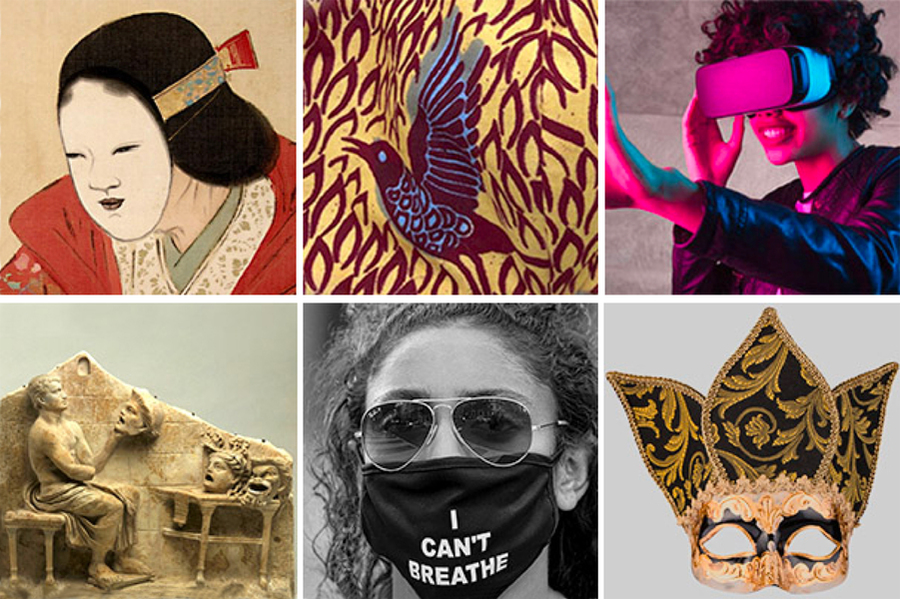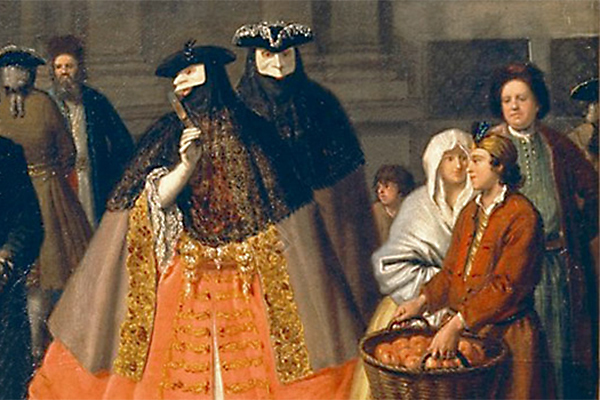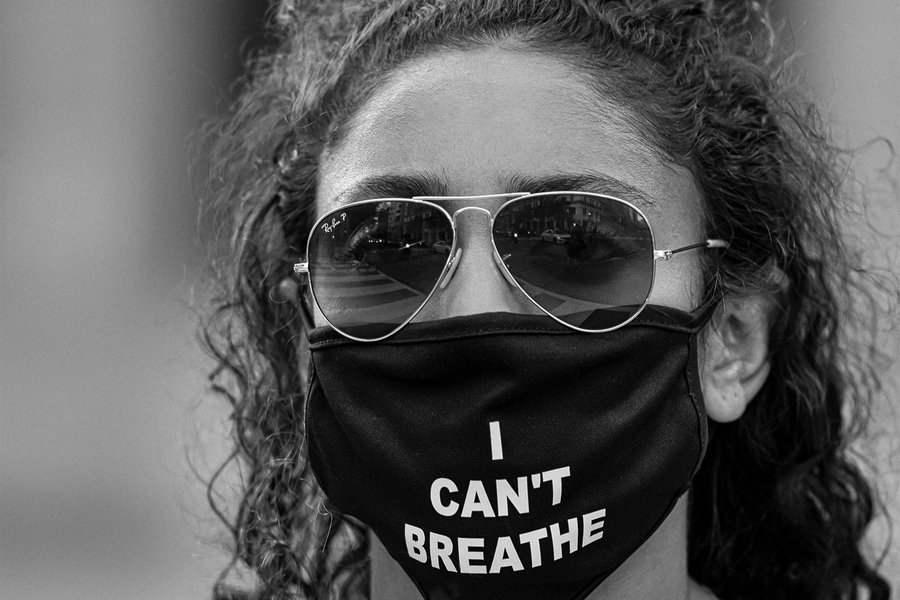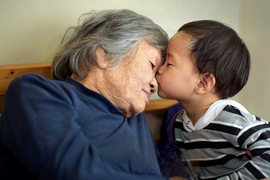As The Washington Post has reported, “at the heart of the dismal U.S. coronavirus response” is a “fraught relationship with masks.” In this series of commentaries — inspired by an idea from associate professor of literature Sandy Alexandre — MIT faculty delve into the cultural, creative, and historic meanings of masks.
Drawing on discipline expertise, the professors offer new ways to think about, appreciate, and practice protective masking — currently a primary way to save lives and to contain the Covid-19 pandemic. The following are distilled excerpts from the commentaries to date; the full, image-rich Meanings of Masks series is available on the MIT SHASS website.
In “The Expressive Power of Masks,” Sara Brown, an assistant professor and the director of design for MIT Theater Arts, writes that: “A performer in a mask is obscuring one identity in order to embody another one. Often, masks for performances have meanings that can be instantly understood by an audience that is familiar with the specific codes embedded in a particular theater form. In Japanese Noh theater, for instance, a mask worn by the principle character can indicate the character’s age and gender, and if the character is human or divine. Though the masks are static and cover the entire face, a skilled performer can invoke a range of expression through changing the mask’s orientation and relationship to light.”
Brown observes that “As we encourage masking at MIT, it’s worth considering how we too can utilize the expressive power of masks. I’m interested in hearing from MIT students,” she says, “for example, as to what affiliations or meanings they would want their masks to communicate. Colors, shape, and insignias, perhaps, could be used to communicate class year, major, residence hall, mood, etc. I trust our inventive students will have dozens of ideas for creating their own masks. And no matter what form it takes, wearing a mask during the pandemic shows that you care about protecting others.”
In “Masks as a Collective Cry for Justice,” Graham Jones, associate professor of anthropology, writes: “The mask is one of the most important human artifacts in all of anthropology. It is a tool of transformation that allows its wearers to transcend themselves, taking on timeless roles in ritual dramas, and as actors in a broader social drama. My favorite ritual masks in the world are those created by the First Nations of North America’s Northwest Coast. Used in dances that tell stories of creation, some of the masks have faces that dramatically transform when properly used in performance. The cloth face coverings that most of us now wear for purely practical, protective reasons may seem symbolically insipid in comparison to sacred masks used in ritual or performance. In practice, however, today's cloth masks have come to figure into everyday interaction rituals in ways that reflect central functions that anthropologists have long associated with masking.”
For me, Jones continues, “the iconic image of our times is of Black Lives Matter protestors of every race wearing masks emblazoned with the dying words of George Floyd: 'I can’t breathe.' These masks represent a symbolic condensation of the two public health crises that define this moment in American history: Covid-19, a disease that kills indiscriminately by attacking the respiratory system, and racism — a disease whose violence is most brutally felt in the choking-to-death of individual Black people at the hands of police. Such protest masks are a creative, expressive way of subsuming one’s identity within a social movement — and one’s voice within a collective cry for justice.”
In “Masks to Finesse an Archaic Political Order,” Jeffrey Ravel, professor of history, writes that in “Early Modern Europe (roughly 1400-1800 CE), masking most frequently occurred during Carnival, a period of raucous celebrations in February or early March that immediately preceded Lent, the six-week period of fasting and penance that culminated in Easter Sunday.” But, Ravel adds, “by the eighteenth century, mask-wearing among all classes and genders extended from Carnival through the summer, lasting half the year. Venetians not only wore masks during the week of Carnival, they continued to wear them through Lent and beyond at the theater, in gambling halls, in public marketplaces, and private homes. Foreign ambassadors and state officials, including the Doge (the head of the Venetian government), wore them during public ceremonies and private meetings and negotiations.”
Why would such extensive masking appeal in 18th-century Venice? Ravel explains that “the families who made up Venice’s patrician caste,” the minuscule percentage “who enjoyed the privilege to participate in the city-state’s political affairs,” had changed dramatically over the centuries, some growing richer and others declining until “by the eighteenth century, social realities did not correspond to the socio-political categories established five hundred years earlier.” Masking, Ravel says (citing fellow historian James H. Johnson) “had become a way to allow Venetians of all classes to intermingle socially, economically, and culturally for a large part of the year without calling into question the archaic political order, and it also allowed those from different socio-economic groupings in search of love to encounter each other in public spaces.”
In “Masks as a Badge of Honor,” Eric Klopfer, head of the Comparative Media Studies/Writing program, writes: “My colleague in CMS/W, Scot Osterweil, often speaks about the ‘four freedoms of play.’ One of these freedoms is the ‘freedom to try on identities.’ Play gives us opportunities to pretend to be other people, creatures, or things. Sometimes we do this simply through imagination, but often we do this by changing our appearance. We play through costumes and masks in real life or through our choice of representations and apparel online, where avatars, or digital representations, can help us explore different identities. This can be empowering as it enables us to see ourselves in new ways; it can also be illuminating to see how others respond to such representations.
“Masks clearly reveal something about mask wearers. Right now, they are being politicized in the U.S. and masks are conspicuous, so it is easy to use them as political identifiers if one chooses to do so. But we can and should change the meaning of this treasured item. In this pandemic era, what a mask really says is, 'I care about you.' That is an important and powerful message. It is one that we should champion and commend. We can also have fun with masks. They can be representations of our favorite characters in real life or fiction. They can take the place of funny and kitschy T-shirts. But the key to any of that is the understanding that, during a pandemic, the mask is a badge of honor, indicating the important role that you are playing in protecting the health of others during a crisis.”
In “The Masks of New Possibilities,” Manduhai Buyandelger, an associate professor of anthropology, writes that “The resistance to wearing a mask for public health purposes in the United States reveals — in addition to political, racial, and gender problems — the degree to which Americans are accustomed to conditions and resources that are not easily accessible in other parts of the world. In Mongolia, where I grew up, a continental climate and high altitude make temporary face coverings or masks an essential part of everyday life. Wearing scarves to protect our faces from frostbite in sub-zero winters or from summer desert dust storms is a normal part of living in Mongolia.”
Buyandelger adds that “Masks are widely used to create alternative realities; examples range from traditional shamanic rituals in Inner Asia to computer-mediated virtual reality (VR) creations anywhere in the world. Such creative masks help wearers to suspend their everyday identities and assume new ones. Alternative worlds provide experiential and experimental spaces in which societies explore issues and share insights in a safe, impersonated way — outside of everyday experience. Hence, a mask often conceals one identity to reveal new possibilities. Seen in this light, virus protection masks offer an opportunity to replace a visage of fear with a public expression of strength as a community. Thus masks become pragmatic and expressive socio-cultural tools for societies and individuals to move forward in confidence.”
In “The Masks of Empire, Politics, and War,” Catherine Clark, an associate professor of cultural history, writes that three of the most meaningful historic masks of the early modern era include the gas masks that became essential gear on the WWI battlefields; the lightweight, prosthetic masks designed with individual care to cover the disfiguring facial wounds of returning WWI soldiers; and the masks made for ceremonial purposes in Africa, Asia, and the Americas that later circulated in 20th century Europe as influential artworks.
Clark also observes that while “mask-wearing is a new marker of American political divisions, in France facial coverings have long been at the heart of political debates. In 2011, France banned individuals from the public wearing of the niqab or burka, both garments typically worn by Muslim women that cover the wearer’s face. This ban built on a 2004 law that forbade ostentatious religious symbols in public schools. These symbols might include Christian crosses and Jewish kippas/yarmulkes, but public debates about the law centered on the Muslim veil as incompatible with the secular values of the French Republic. This spring, protective masks became mandatory in public in France, and yet, the burka and niqab remained banned. At the same time, in the U.S., many people of color described not feeling safe wearing masks, even needed protective masks, in public. These two cases, while based in very different issues, reveal the degree to which politics, cultural norms, and bias dictate who can cover their faces and how.”
In “Masks as 公德心,” Emma Teng, the T.T. and Wei Fong Chao Professor of Asian Civilizations; and director of MIT Global Languages, writes that “In general, I think too much has been made of the supposed difference between American ‘individualism’ and Asian ‘collectivism.’ However, when it comes to wearing face masks, certain aspects of culture have almost certainly been coming into play.” Teng cites the “communitarian norms in East Asian countries” that support the ethos that “doing something for the community good is good for me also. This value is known as 公德心: in Mandarin: gongdexin; in Japanese: kootokushin; in Korean: Kongdokshim; and in English: ‘public spiritedness.’”
In addition, Teng notes that “Confucianism, a philosophy that has significantly influenced East Asian cultures, encourages great respect for elders and care for young children,” and that “if wearing a face mask can help protect someone’s grandparents, that is your duty.” Similarly, “it is considered a social responsibility to do one’s part in controlling the pandemic to ensure that schools remain open for the younger generation.” Teng also notes that “In East Asia, face masks are worn for a wide range of purposes. Combating urban pollution is a top reason, and it’s also common to wear a face mask to prevent allergies or to provide a little extra privacy in densely populated East Asian cities.” And “In cold and flu season … if you have a cold yourself, you are expected as a matter of basic etiquette to wear a face mask in public, in the office, and at school.”
In “Persona: Masks in the Graeco-Roman World,” Stephanie Ann Frampton, an associate professor of classical literature, writes that "In Latin, one of the words for mask is persona, thought to have meant 'something through which sound passes' (per, 'through;” sono, “to make a sound'). Even in the time of Cicero, persona was already being used to describe the 'part' or 'character that one sustains in the world' — in other words, the role or roles we play in society.”
Frampton finds that “What’s most interesting about the masks in the classical period is that they often served the inverse purpose from the masks we’re wearing today to prevent the spread of disease. Theatrical masks in the ancient Graeco-Roman world functioned effectively as megaphones, leaving the mouth uncovered and allowing the voice to be projected to a large audience while covering the rest of the head and face with a typically exaggerated fixed expression. The best known masks from this period are, of course, those of comedy and tragedy, though many other types of masks were used for theatrical and religious performances, which ranged from satyr plays to cult rituals." Frampton suggests that "One of the things we can learn from ancient theatrical masks is that emotion and feeling are revealed through the eyes and not just the mouth — something we can take to heart as we communicate with others while we all wear masks during this pandemic.”
Series prepared by MIT SHASS Communications
Series editor/designer: Emily Hiestand
Consulting editor: Kathryn O'Neill











